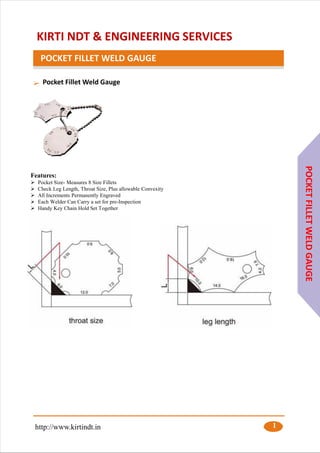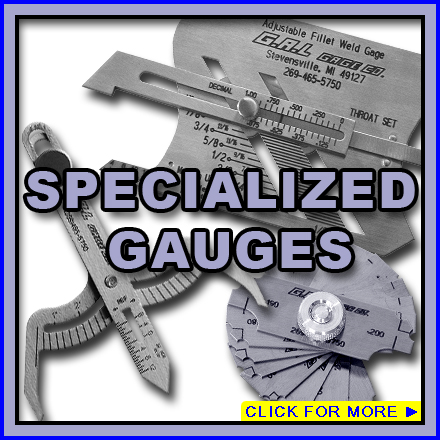Cutting-edge Methods to Fillet Weld Inspection and Testing: Enhancing Weld Quality and Conformity Specifications
In the world of welding, the high quality and integrity of fillet welds play a crucial role in ensuring the architectural stability and dependability of different industrial components. With the constant drive for improved effectiveness and conformity with rigorous requirements, the expedition of innovative techniques to fillet weld assessment and testing has actually ended up being necessary.
Advanced Non-Destructive Testing Methods
Utilizing cutting edge innovations, progressed non-destructive testing approaches play a vital duty in making sure the honesty and quality of fillet welds. These techniques, such as phased range ultrasonic screening (PAUT) and magnetic bit screening (MPT), offer thorough understandings right into the weld's internal structure without causing any kind of damage to the material. PAUT, for example, makes use of multiple ultrasonic elements to evaluate the weld from numerous angles, giving a thorough visualization of potential flaws like absence of blend or cracks.
In A Similar Way, MPT is reliable in spotting surface-breaking problems by using an electromagnetic field and iron particles to the weld area. This approach is especially helpful for recognizing gaps that might endanger the weld's strength. By using these advanced non-destructive screening methods, weld inspectors can precisely evaluate the high quality of fillet welds, guaranteeing conformity with sector requirements and regulations. The capability to detect imperfections early on not just improves weld top quality but likewise stops expensive rework or failures in structural integrity, underlining the importance of these cutting-edge screening techniques in welding inspections.
Robotics and Automation in Assessment

The assimilation of robotics and automation has actually changed the evaluation procedure for fillet welds, enhancing performance and accuracy in quality analysis. Robotics provide specific control and repeatability in checking welds, ensuring reliable and regular outcomes. Automated systems can be programmed to adhere to details inspection paths, making certain extensive insurance coverage of welds and lowering the danger of human error.
Robotic examination systems furnished with advanced sensing units can detect and determine weld functions with high accuracy, supplying detailed data for analysis. These systems can determine flaws such as splits, absence of combination, and porosity, enabling punctual corrective actions to be taken. Furthermore, robotics and automation enable real-time information collection and analysis, providing prompt comments to operators and assisting in quick decision-making procedures.
Moreover, making use of robotics and automation in fillet weld inspection enhances overall performance by decreasing examination times and boosting examination throughput. By improving the examination process, suppliers can guarantee weld top quality and compliance standards are satisfied successfully, eventually bring about cost savings and boosted item quality.
Making Use Of Expert System for Analysis
Fabricated knowledge plays a pivotal function in enhancing the performance and precision of analysis in fillet weld inspection procedures. AI algorithms can quickly process vast amounts of information from weld inspections, spotting flaws or disparities that might be challenging to identify with the naked eye.
In addition, AI systems can pick up from past examination information, continuously enhancing their ability to recognize prospective problems and inconsistencies in fillet welds. This adaptive understanding capacity enhances the total quality assurance process, minimizing the possibility of human mistake and making sure that welds fulfill the needed criteria. By incorporating artificial intelligence right into fillet weld evaluation, markets can accomplish higher levels of efficiency, uniformity, and conformity in their examination practices.
Portable Tools for On-Site Examination
Enhancing area examination performance, the adoption of portable tools changes on-site assessment processes for fillet welds. These tools offer flexibility and ease, allowing inspectors to carry out comprehensive examinations in various locations, including remote or challenging environments. Portable tools such as ultrasonic screening tools, try here magnetic particle inspection equipment, and digital radiography systems offer real-time information and high-resolution imaging capacities, making it possible for fast decision-making and immediate comments on weld high quality.
One significant benefit of mobile devices is their capacity to improve examination treatments, minimizing downtime and improving general performance - Gauge Fillet Weld. Assessors can easily transfer these devices to various work sites, getting rid of the need for moving heavy machinery or components to off-site centers. Furthermore, the mobility of these tools promotes cost-effectiveness by minimizing transportation costs and accelerating evaluation timelines
Furthermore, the usage of portable devices for on-site assessment advertises proactive quality assurance procedures, as assessors can immediately determine and resolve any kind of possible welding problems or disparities. By integrating these cutting-edge innovations right into on-site examination methods, welding professionals can make sure compliance with sector standards and boost weld high quality, ultimately causing improved structural integrity and safety and security in various welding applications.
Combination of Data Monitoring Systems

Having optimized on-site examination processes through the utilization of mobile tools, the following stage includes the seamless combination of information management systems to further enhance effectiveness and information analysis content abilities in fillet weld inspection and testing. By incorporating data administration systems right into the examination process, organizations can enhance information collection, storage space, and analysis. This integration permits real-time tracking of weld high quality, instant identification of issues, and punctual decision-making to rectify any type of issues that may occur during the evaluation procedure.
Data monitoring systems play a crucial role in streamlining examination data, assisting in simple gain access to for accredited personnel, and ensuring data integrity and safety. With the combination of these systems, examiners can generate extensive reports, track historical data for fad analysis, and boost total procedure efficiency. The integration of data management systems makes it possible for smooth interaction in between different stakeholders involved in the evaluation process, cultivating collaboration and enhancing total high quality control measures. Ultimately, the combination of data monitoring systems offers to elevate the standards of fillet weld examination and testing, ensuring compliance with sector regulations and boosting weld high quality.
Verdict
Finally, cutting-edge techniques to fillet weld examination and testing have actually considerably improved weld top quality and conformity requirements. Advanced non-destructive testing techniques, robotics, automation, expert system, portable devices, and information management Check Out Your URL systems have reinvented the method weld assessments are performed. By utilizing these technologies, industries can guarantee that welds satisfy the needed high quality requirements and laws, inevitably boosting general efficiency and safety in welding processes.

Having optimized on-site evaluation processes via the application of mobile tools, the next stage involves the smooth assimilation of information administration systems to better boost efficiency and data analysis capabilities in fillet weld evaluation and testing. Ultimately, the assimilation of data administration systems serves to raise the standards of fillet weld examination and screening, making sure conformity with sector laws and improving weld top quality.
